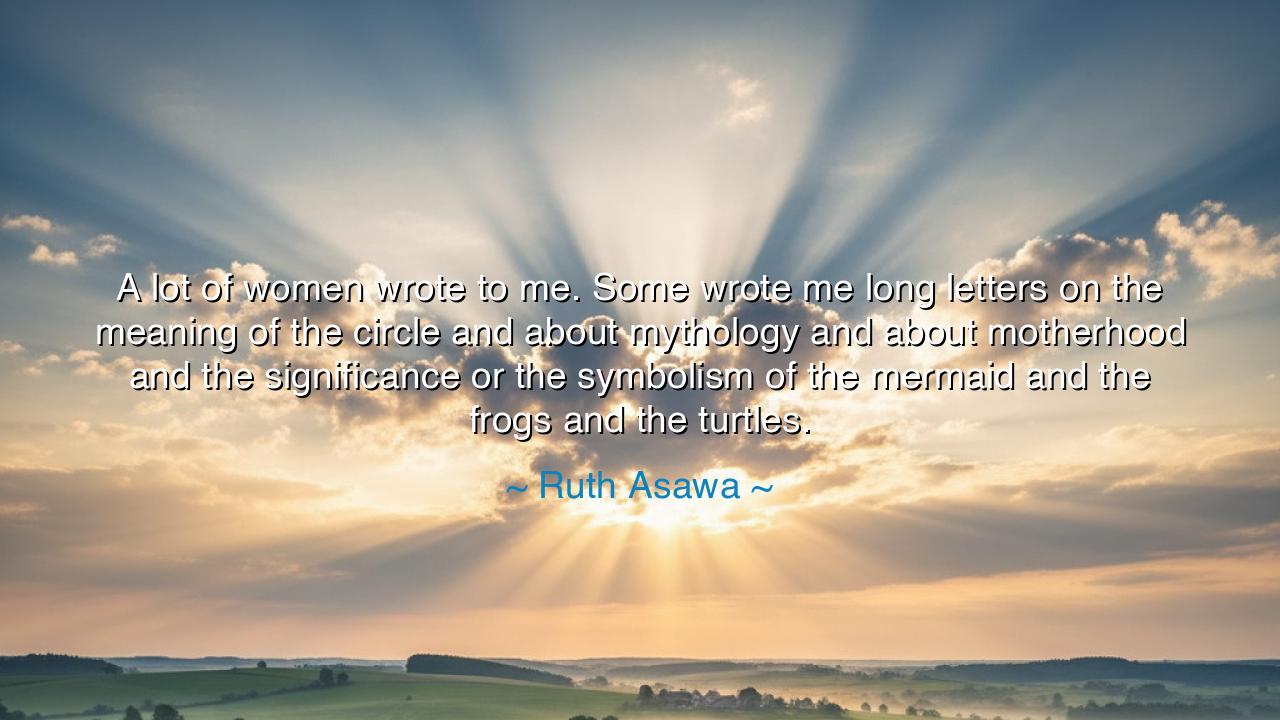
A lot of women wrote to me. Some wrote me long letters on the
A lot of women wrote to me. Some wrote me long letters on the meaning of the circle and about mythology and about motherhood and the significance or the symbolism of the mermaid and the frogs and the turtles.






When Ruth Asawa reflected, “A lot of women wrote to me. Some wrote me long letters on the meaning of the circle and about mythology and about motherhood and the significance or the symbolism of the mermaid and the frogs and the turtles,” she revealed how art becomes more than form—it becomes communion. The circle, ancient and eternal, speaks to women of wholeness, cycles, and unbroken continuity. In her sculptures, Asawa gave shape to this truth, and in response, countless women recognized their own stories mirrored back: stories of mythology, motherhood, and the symbols of life that have guided humanity since its dawn.
Her words remind us that art is not a solitary act, but a dialogue. When she wove wire into spheres and spirals, she was not merely creating objects but weaving together memory, culture, and spirit. The women who wrote to her carried forward this dialogue, showing how deeply these shapes resonated. Mermaids, long symbols of transformation and mystery, frogs of renewal, and turtles of endurance and the earth itself—all became part of a shared language between artist and audience, a language older than words.
The ancients knew this bond between symbol and soul. In Egypt, the circle represented eternity, the endless sun that rises again each day. In India, the mandala embodied the universe itself, a map of cosmic order. And in every culture, animals like the turtle or the frog were never mere creatures, but messengers of life’s deeper rhythms. Asawa, knowingly or not, tapped into this vast heritage, becoming a vessel through which ancient meanings reawakened in modern hearts.
Her story mirrors that of other creators whose work became more than themselves. Think of Hildegard of Bingen, the medieval mystic who saw visions in patterns of light and music, and whose symbols gave solace and inspiration to her followers. Like Hildegard, Asawa did not dictate meaning but invited it—opening the space where each person might find their own reflection within her work.
Thus, let her wisdom endure: true art is not only the work of the hands but of the spirit, connecting generations across time. The circle, the mermaid, the frog, the turtle—these are not ornaments, but bridges between the seen and the unseen, the personal and the universal. And in this communion lies the secret of immortality: that art, when born of truth, outlives its maker, and speaks forever to those who seek meaning in its form.






TNTinh Nguyen
The way Ruth Asawa describes the letters from women reflects how art can spark conversation and personal reflection. The significance of symbols like frogs or mermaids seems to offer more than just artistic value—they carry cultural and emotional weight. How do we, as a society, interpret symbols in ways that connect with us on a deeper level? And can this kind of interpretation empower individuals to find their own meanings in art?
DTTran Duc Thuan
I’m intrigued by how Ruth Asawa highlights the personal and symbolic interpretations women had of her work. Symbols like the circle, the mermaid, and turtles must have held deep meanings for these women. How do artists, knowingly or unknowingly, invite such deep reflection through their work? Can symbols carry different meanings based on the viewer's personal life experiences, or are they inherently tied to universal meanings?
DHDung Hoang
It’s interesting how Asawa describes the letters she received, which reveal a lot about how different people, especially women, perceive art through the lens of mythology and symbolism. The mention of things like the mermaid or frogs feels almost like they represent archetypes in our collective consciousness. How can symbols transcend time and culture in the way Asawa suggests, and what does that say about the human need for connection and meaning?
NHNhung Hong
Ruth Asawa’s reflection on the letters she received from women is fascinating, especially the way they connected deeply with her work. The way people interpret art, especially through symbols like the circle or the mermaid, speaks to the powerful emotional and cultural resonance art can have. What do you think it is about certain symbols, like mermaids or turtles, that draw such profound connections in people's lives? Is it more personal or universal?